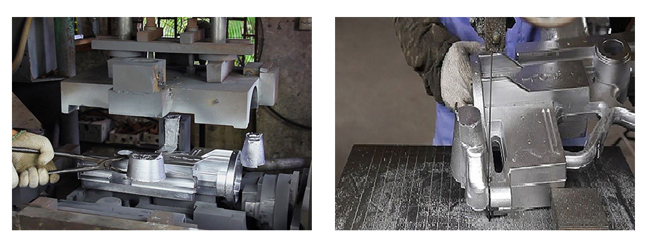In any casting process it becomes tough to judge the exact cause of defects because they are quite perceptive in nature. Therefore, first of all, it is necessary to identify the process parameters that considerably affect the quality of the casting product. In the case of gravity die casting process, some common parameters have been listed below to assess their contribution in affecting the gravity die casting process.
- Pouring velocity
- Melt holding time
- Pouring time
- Mold temperature at the time of pouring
- Gate and riser design
- Degasification
- Preheat temperature
- Die coat material and thickness
Permanent Mold Casting Process
These parameters are common to any gravity die casting process. However, some of them are critical and need better understanding.
Pouring temperature
Pouring temperature generally varies between 650-800° C. In the case of Aluminium alloys, their fluidity is wholly dependent on the pouring temperature. This is fundamentally due to the fact that at higher temperature viscosity of the molten material decreases and as a result that fluidity increases. Pouring temperature is also directly related to the filling speed, at higher pouring temperature filling speed increases. Moreover, pouring temperature also affects the microstructure of the cast product which in turn affects the mechanical properties of the product.
Gate and riser design
Liquid metal is introduced into the mold through the feeder which acts as a liquid metal reservoir. Risers also serve as a heat reservoir, creating a temperature gradient that induces directional solidification. Feeders can be top or side types. The design of the feeders, risers, and gating system considerably affects the quality of the product. If they are not properly designed, then cast products will have defects.
Preheat temperature
Preheating is very important in gravity die casting, helping to remove the formation of temperature gradients during the casting process. Preheating needs to be done in a particular range. If the preheat temperature is above the range, then it could affect die coating and ultimately product surface finish.
Degasification
Argon and nitrogen are frequently used for the degasification process. Inert gas is passed through the injection nozzles & bubbled through molten metal to remove absorbed hydrogen. The bubbling action of inert gas through a spinning rotor helps oxide particles to float to the surface. Degassing fluxes are also added to remove hydrogen from the molten metal as well as to lift oxides and particles to the top of the bath so that they can be removed.
Die coat thickness and material
To obtain a smooth surface finish of the casted product, dies are coated in the gravity die casting process. If the molten metal directly comes in contact with the mold, then a direct chilling effect occurs. Calcium carbide, silicon mixtures, and graphite are typically used as coating materials. Proper coat thickness and suitable materials are necessary in order to produce good quality cast products.

Our R&D team at Omnidex has optimized suitable process parameters, with the research and experience of years. Now, we are running our gravity die casting systems at the appropriate parameters for every kind of material so that our customers can get defect-free products. You can contact us by email if you have any questions or if you need metal casting foundry cooperation.











Water Sector Talent Exodus Could Cripple The Sector
Well let´s do a little experiment. My last (10.4.25) half-yearly water/waste water bill from Severn Trent was £98.29. How much does not-for-profit Dŵr...